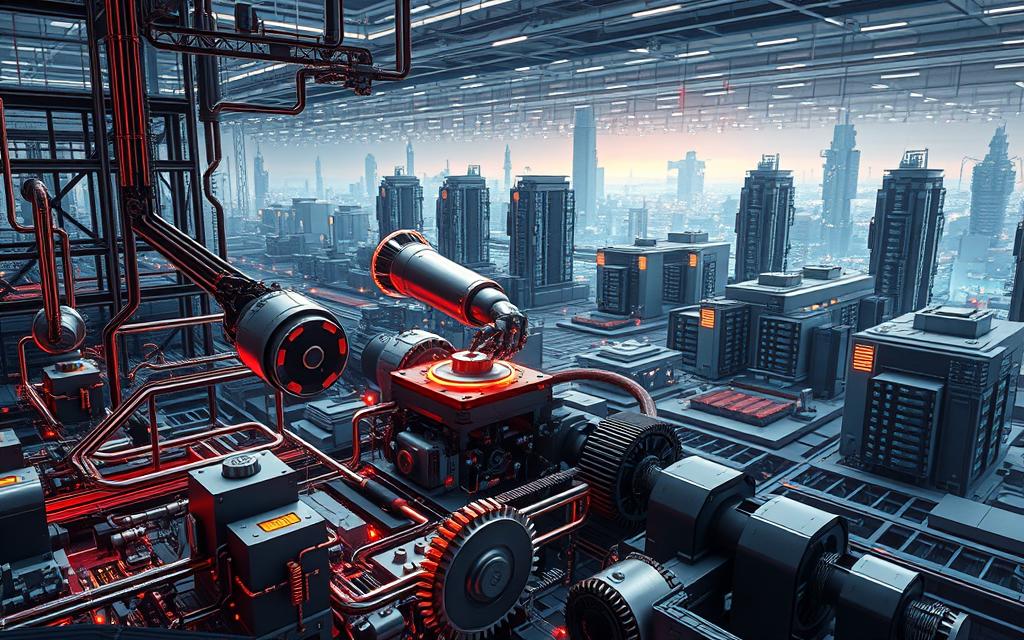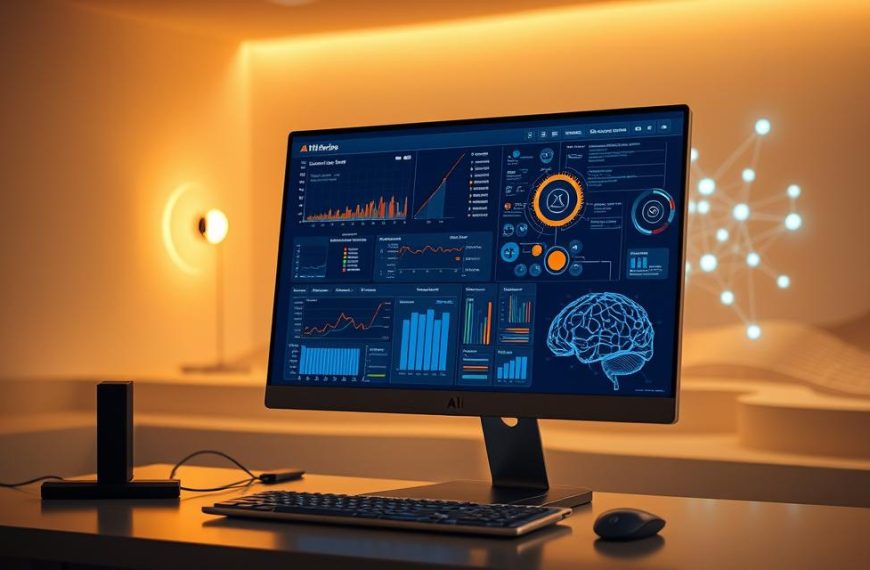Businesses often confuse machine learning with automation, but these systems serve distinct purposes. Andreas Roell of Analytics Ventures highlights that machine learning focuses on identifying future data signals, while automation handles repetitive tasks efficiently.
McKinsey’s 2021 report reveals that 27% of companies experienced at least a 5% EBIT growth through AI adoption. This underscores the transformative potential of these technologies in modern business environments.
For example, automation excels in rule-based processes like email triggers. In contrast, machine learning predicts outcomes, such as optimal invoice timing. These differences highlight how each technology enhances processes uniquely.
Understanding these distinctions helps businesses leverage the right tools for their needs. While automation streamlines tasks, machine learning drives intelligent decision-making through data analysis.
What Is Machine Learning?
At its heart, machine learning transforms raw data into actionable insights. This subset of artificial intelligence (AI) relies on statistical patterns in historical information to predict outcomes or make decisions.
Definition and Core Concepts
Machine learning involves creating models that learn from data without explicit programming. Neural networks, a key component, mimic the human brain to handle complex tasks like image recognition or language processing.
“Neural networks enable machines to process vast amounts of information, uncovering hidden patterns that drive intelligent decision-making.”
How Machine Learning Works
The process begins with data ingestion, where raw information is collected and prepared. Next, pattern recognition identifies trends, followed by predictive modeling to forecast future outcomes.
For example, Google Maps uses algorithms to predict traffic conditions and accidents. Similarly, NVIDIA’s KAI Scheduler manages AI workloads through Kubernetes, scaling workloads up to 20x using GPU orchestration.
| Phase | Description |
|---|---|
| Data Ingestion | Collecting and preparing raw data for analysis. |
| Pattern Recognition | Identifying trends and relationships in the data. |
| Predictive Modeling | Creating models to forecast future outcomes. |
Understanding these phases helps businesses leverage machine learning effectively. For more insights, explore the differences between machine learning vs. automation.
What Is Automation?
Automation has become a cornerstone of modern business operations. It involves using software to handle repetitive tasks, freeing up human resources for more complex activities. Unlike systems that adapt, automation follows predefined rules, ensuring consistency and precision.
Definition and Key Characteristics
At its core, automation executes tasks without adaptation. Think of a water wheel—it performs the same motion repeatedly, much like how automation handles processes. Basic workflows, such as “if X then Y,” exemplify this approach. For instance, legacy chatbots follow scripted responses, while AI-powered systems adapt dynamically.
Key characteristics include:
- Rule-based execution
- Consistency in task completion
- Enhanced efficiency and reduced errors
Examples of Automation in Everyday Life
Automation impacts various aspects of life and business. In marketing, tools like Constant Contact and Zoho CRM send abandoned cart emails with dynamic fields, boosting engagement. Compliance automation speeds up contract reviews, increasing throughput significantly.
In customer service, traditional IVR systems are being replaced by NLP-driven bots, improving response time. The Brookings Institution highlights Amazon’s use of conveyor belt anomaly detection, showcasing automation’s role in logistics. These solutions demonstrate how automation drives efficiency across industry sectors.
Is Machine Learning Automation? Understanding the Differences
The line between advanced systems often blurs in practical applications. While both aim to enhance efficiency, their approaches and outcomes differ significantly. Recognizing these distinctions helps businesses choose the right solutions for their needs.
Key Differences Between Machine Learning and Automation
Automation excels in handling repetitive tasks with fixed rules. For example, high-volume invoice processing benefits from its consistency. In contrast, adaptive systems like ML thrive in variable conditions, such as fraud detection in transaction data.
| Feature | Automation | Machine Learning |
|---|---|---|
| Workflow | Static and rule-based | Dynamic and adaptive |
| Use Case | Invoice processing | Fraud detection |
| Decision Making | Predefined rules | Pattern recognition |
“Automation ensures consistency, while ML drives intelligent decisions through data analysis.”
When to Use Machine Learning vs. Automation
For routine tasks, automation delivers unmatched efficiency. Compliance teams, for instance, handle 97% of cases using this approach. However, ML shines in identifying anomalies, offering strategic results in complex scenarios.
NVIDIA Run:ai’s dynamic scheduling claims zero manual intervention in scaled deployments. This innovation highlights ML’s potential in resource-intensive environments. Yet, businesses must avoid ML overkill, especially with small datasets like quarterly approval processes.
- Automation: Best for high-volume, rule-based tasks.
- Machine Learning: Ideal for predictive analysis and pattern recognition.
Antone Martinho-Truswell’s efficiency evolution theory underscores the importance of aligning tools with specific needs. A cost-benefit analysis reveals that while automation saves costs, ML drives long-term strategic gains.
Applications of Machine Learning and Automation
Modern industries leverage advanced technologies to optimize operations. These solutions enhance performance and streamline workflows across sectors. From manufacturing to healthcare, the strategic deployment of these tools drives significant improvements.
Machine Learning in Industry
In manufacturing, predictive maintenance systems analyze equipment data to prevent failures. This approach reduces downtime and boosts performance. Similarly, healthcare benefits from drug discovery models that accelerate research timelines.
Financial institutions rely on algorithmic trading to make data-driven decisions. These capabilities ensure accuracy and efficiency in high-stakes environments. NVIDIA Run:ai, for instance, accelerates AI lifecycles, achieving a 5x utilization boost in deployment.
Automation in Business Processes
Automation excels in repetitive tasks, such as robotic assembly lines in manufacturing. In healthcare, automated patient scheduling systems improve resource allocation. Finance leverages fraud alerts to enhance security.
Red Marker automates marketing compliance, using RiskGPT for copy reviews. This development ensures adherence to regulations while saving time. Retail integrates demand forecasting with inventory robots, optimizing supply chains.
| Sector | Machine Learning Application | Automation Application |
|---|---|---|
| Manufacturing | Predictive maintenance | Robotic assembly lines |
| Healthcare | Drug discovery | Patient scheduling |
| Finance | Algorithmic trading | Fraud alerts |
These examples highlight the transformative capabilities of these technologies. By understanding their unique strengths, businesses can implement the right tools for maximum impact.
Conclusion
In today’s fast-paced digital landscape, understanding the synergy between advanced technologies is crucial. Machine learning excels in adaptive prediction, while automation focuses on enhancing efficiency in repetitive tasks. Together, they form a powerful combination in modern tech stacks.
NVIDIA Run:ai’s hybrid cloud orchestration capabilities demonstrate how intelligent resource pooling can boost GPU availability by 10x. This innovation highlights the potential for businesses to optimize their processes.
As industries evolve, emerging job categories like AI-augmented call centers underscore the transformative impact of these technologies. However, businesses must audit their workflows to identify opportunities for synergy between machine learning and automation.
Regulatory pitfalls remain a concern, emphasizing the need for human oversight. A strategic assessment framework can guide effective implementation, ensuring informed decisions that drive long-term success.















